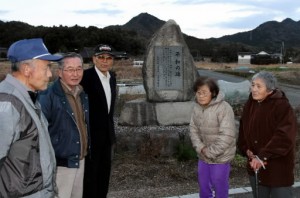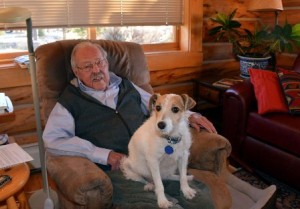Death of Thomas Cartwright, Hiroshima POW, is mourned by local residents
Jan. 30, 2015
by Ryutaro Inoue and Sakiko Masuda, Staff Writers
The news of Thomas Cartwright’s death reached residents of the Ikachi area of Yanai, Yamaguchi Prefecture on January 15. Mr. Cartwright, 90, was the pilot of a U.S. fighter jet in World War II. He became a prisoner of war in Hiroshima after his plane was shot down toward the end of the war. Residents of Yanai who live near the site where his plane crashed recalled their encounter with Mr. Cartwright, who had parachuted from the aircraft.
Masuno Ito, 87, witnessed the plane go down. “Back then, people were filled with hate for American soldiers,” she said. “Some people wanted to attack the crew members [who parachuted to the ground], but others told them not to. Some women treated their wounds.”
Residents of the town later came into contact with Mr. Cartwright when parts of the airplane were returned to the United States and there was an exchange of letters. With the firm belief that no more wars should be waged, they collected contributions and, in 1998, raised a peace monument near the place where the plane crashed. The following year, the monument was unveiled in a ceremony attended by Mr. Cartwright. Noriaki Fujinaka, 70, who directed the ceremony, recalled, “Mr. Cartwright was pleased to see the monument for peace. I remember it very well.”
Yoshitaka Fujisato, 78, also saw the plane go down. He met Mr. Cartwright at the unveiling ceremony for the monument. “When we saw each other, we smiled and the feelings of hate disappeared,” he said. “I felt strongly that we should convey our message of no more war.”
◇
by Yumi Kanazaki, Staff Writer
Thomas Cartwright lived a quiet life with his dog in Moab, Utah, known for a striking valley that stretches from the Grand Canyon. On December 9, 2014, about a month before his death, he was interviewed by the Chugoku Shimbun. He spoke in even tones, stressing that he did not want people to forget about the six members of his crew who were held prisoner in Hiroshima and perished in the atomic bombing 70 years ago.
Though his body had become frail, his memories were still fresh. He recounted the tense moments when he jumped from his stricken plane. He also shared how he had lived with the guilt of having survived while other members of his crew died cruel deaths. [Thomas Cartwright escaped the atomic bombing because he was transferred to Tokyo before the A-bomb attack on Hiroshima.]
When he came to Japan to attend an academic conference in 1983, he paid a visit to Hiroshima. He said his emotions weighed heavily on him as he reflected on his lost colleagues and the other victims of the bombing.
Things changed in 1996. Parts of his plane were returned to him through the efforts of the late Keiichi Muranaka, a former junior high school principal and Yanai resident. These parts had been refashioned into farming equipment and cooking pots and used by the people living near the crash site. Mr. Cartwright was moved to see that items once used to wage war had been made into tools for living. He also developed ties with Shigeaki Mori, a Hiroshima resident who investigated the fate of the POWs who died in the atomic bombing. Mr. Cartwright then visited Japan again in 1999.
During our recent interview, he expressed gratitude to the people he met in Japan. “I really appreciate that they created a peace monument in memory of my colleagues.” He also said it was wonderful that former enemies were able to take part in a peaceful exchange and deepen their mutual understanding.
Mr. Mori had maintained his correspondence with Mr. Cartwright. Wiping away tears, Mr. Mori said, “He was always conscious of the responsibilities of those who survived. I was impressed when he talked about the importance of a peaceful world without nuclear weapons. We must continue sharing his feelings for his colleagues here in Hiroshima.”
(Originally published on January 16, 2015)
The news of Thomas Cartwright’s death reached residents of the Ikachi area of Yanai, Yamaguchi Prefecture on January 15. Mr. Cartwright, 90, was the pilot of a U.S. fighter jet in World War II. He became a prisoner of war in Hiroshima after his plane was shot down toward the end of the war. Residents of Yanai who live near the site where his plane crashed recalled their encounter with Mr. Cartwright, who had parachuted from the aircraft.
Masuno Ito, 87, witnessed the plane go down. “Back then, people were filled with hate for American soldiers,” she said. “Some people wanted to attack the crew members [who parachuted to the ground], but others told them not to. Some women treated their wounds.”
Residents of the town later came into contact with Mr. Cartwright when parts of the airplane were returned to the United States and there was an exchange of letters. With the firm belief that no more wars should be waged, they collected contributions and, in 1998, raised a peace monument near the place where the plane crashed. The following year, the monument was unveiled in a ceremony attended by Mr. Cartwright. Noriaki Fujinaka, 70, who directed the ceremony, recalled, “Mr. Cartwright was pleased to see the monument for peace. I remember it very well.”
Yoshitaka Fujisato, 78, also saw the plane go down. He met Mr. Cartwright at the unveiling ceremony for the monument. “When we saw each other, we smiled and the feelings of hate disappeared,” he said. “I felt strongly that we should convey our message of no more war.”
◇
Reporter recalls recent interview with Thomas Cartwright
by Yumi Kanazaki, Staff Writer
Thomas Cartwright lived a quiet life with his dog in Moab, Utah, known for a striking valley that stretches from the Grand Canyon. On December 9, 2014, about a month before his death, he was interviewed by the Chugoku Shimbun. He spoke in even tones, stressing that he did not want people to forget about the six members of his crew who were held prisoner in Hiroshima and perished in the atomic bombing 70 years ago.
Though his body had become frail, his memories were still fresh. He recounted the tense moments when he jumped from his stricken plane. He also shared how he had lived with the guilt of having survived while other members of his crew died cruel deaths. [Thomas Cartwright escaped the atomic bombing because he was transferred to Tokyo before the A-bomb attack on Hiroshima.]
When he came to Japan to attend an academic conference in 1983, he paid a visit to Hiroshima. He said his emotions weighed heavily on him as he reflected on his lost colleagues and the other victims of the bombing.
Things changed in 1996. Parts of his plane were returned to him through the efforts of the late Keiichi Muranaka, a former junior high school principal and Yanai resident. These parts had been refashioned into farming equipment and cooking pots and used by the people living near the crash site. Mr. Cartwright was moved to see that items once used to wage war had been made into tools for living. He also developed ties with Shigeaki Mori, a Hiroshima resident who investigated the fate of the POWs who died in the atomic bombing. Mr. Cartwright then visited Japan again in 1999.
During our recent interview, he expressed gratitude to the people he met in Japan. “I really appreciate that they created a peace monument in memory of my colleagues.” He also said it was wonderful that former enemies were able to take part in a peaceful exchange and deepen their mutual understanding.
Mr. Mori had maintained his correspondence with Mr. Cartwright. Wiping away tears, Mr. Mori said, “He was always conscious of the responsibilities of those who survived. I was impressed when he talked about the importance of a peaceful world without nuclear weapons. We must continue sharing his feelings for his colleagues here in Hiroshima.”
(Originally published on January 16, 2015)








